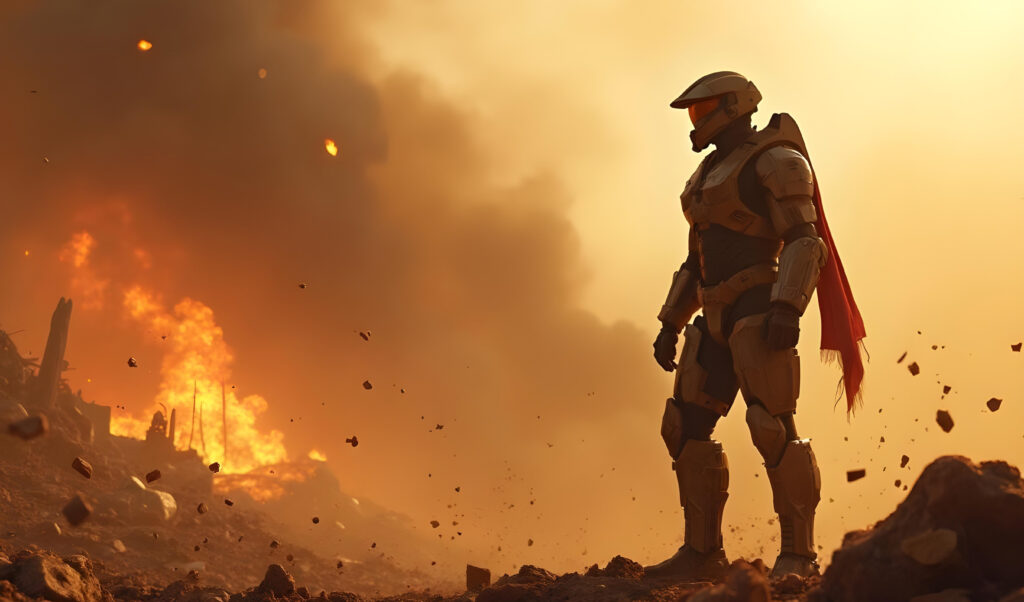The Halo (2003) game icons banners played an essential role in shaping the identity and success of Halo: Combat Evolved. These visual elements weren’t just there for decoration; they were integral to the player’s experience, offering both functionality and immersion. Released during a period of rapid evolution in video games, Halo’s iconic banners and in-game symbols stood out, helping the game solidify its place as one of the most memorable franchises in gaming history.
From the Master Chief’s iconic helmet to the distinct Halo ring, these designs became synonymous with the series, making them recognizable even outside the gaming world. The combination of simple but effective visuals—both in game icons and banners—was key to Halo’s success and longevity. In this article, we’ll take a closer look at the Halo (2003) game icons banners, examining their significance and lasting impact.
Table of Contents
The Role of Game Icons in Halo (2003)
In halo (2003) game icons banners weren’t just random symbols—they were functional tools designed to streamline gameplay. These icons included everything from health and shield indicators to weapon and vehicle symbols, each serving a specific purpose. The Halo (2003) game icons were clear, simple, and easy to recognize, which made them vital for the fast-paced, intense battles players faced.
Take, for example, the Master Chief’s helmet icon, which became one of the most recognizable game symbols ever. This icon represented more than just the main character—it encapsulated the entire series’ aesthetic of futuristic, military sci-fi. Similarly, the Halo ring icon tied directly to the game’s narrative, representing the mysterious ringworld that serves as the setting of the game. These icons didn’t just provide gameplay information—they became part of the larger lore and identity of Halo.
Banners: A Key Part of Halo’s Branding
The banners in halo (2003) game icons banners were more than just visual art—they were crucial tools for creating a cohesive and immersive gaming world. These banners, featuring key characters like Master Chief, placed in epic, futuristic settings, became iconic representations of the game’s universe. The most notable were the promotional banners used to market the game, prominently displaying Master Chief against the backdrop of alien landscapes. These banners were designed to evoke feelings of grandeur and excitement, hinting at the epic adventure awaiting players in the Halo universe.
Not only did these banners establish the game’s identity, but they also played a huge role in building the Halo brand. Each banner was meticulously designed to reflect the game’s core themes—war, heroism, and survival—while using a color palette that symbolized the sci-fi nature of the game. The green and metallic tones, combined with bold imagery of space battles and alien technology, became synonymous with the Halo experience. These visuals weren’t limited to the in-game environment; they extended into marketing campaigns, ensuring that every piece of content related to Halo felt unified and instantly recognizable.

Design Choices Behind halo (2003) game icons banners
The in-game banners, too, were created with a clear purpose: to immerse players in the game’s rich universe while providing critical information without breaking the flow of gameplay. Banners representing the UNSC, Covenant, and other factions were carefully designed to blend seamlessly into the environment while enhancing the sci-fi military atmosphere. For example, the Covenant banners, with their alien symbols and sleek, futuristic designs, helped convey the otherworldly nature of the faction, making it feel distinct and threatening. Similarly, the UNSC banners, often characterized by military insignias and a more grounded, industrial design, contrasted the alien forces, reinforcing the game’s ongoing conflict between humanity and the Covenant
FAQs on Halo (2003) Game Icons Banners (continued)
How did Halo’s icons and banners influence future games?
The influence of Halo (2003) game icons banners extended well beyond its release, shaping the design language of many future video games. The minimalist approach Bungie employed with the game icons, such as the distinct weapon icons or health indicators, was a game-changer for the FPS genre. Many developers followed suit, recognizing that intuitive and clear icons could greatly enhance the user experience without compromising the aesthetic of the game. The use of clean, easily recognizable symbols allowed players to stay immersed in the action, without the need for overly complex HUDs (Heads-Up Displays). This balance between function and form set a new standard for games that came after, influencing everything from in-game menus to multiplayer HUDs.
The banners also had a major impact on the marketing and promotional strategies of video games. Halo’s promotional materials, especially its banners, which featured bold, heroic imagery of Master Chief and expansive alien landscapes, shifted how games were visually marketed. Prior to Halo, many game banners were functional and lacked the cinematic appeal that Halo introduced. After Halo, more games began to adopt this epic, cinematic style in their marketing campaigns, aiming to create not just a game, but an entire world for players to immerse themselves in. This approach continues to shape the way blockbuster games are promoted today.
Can fans still access or recreate the original Halo (2003) game icons and banners?
Yes, the Halo (2003) game icons banners continue to live on in various forms, thanks to the active fan community that surrounds the franchise. Many fans recreate and remaster these icons and banners, often producing high-quality digital art that pays homage to the original designs. These can be found on fan sites, forums, and through platforms like DeviantArt and Reddit, where fans of the game share their creations. Additionally, fan-made banners often feature custom icons and emblems inspired by the original game, showing how deeply the visuals of Halo have resonated with its community.
For collectors, original promotional banners from 2003 can sometimes be found through online auction sites like eBay, where vintage gaming memorabilia is bought and sold. These banners, especially those featuring iconic imagery like Master Chief or the Covenant insignia, are highly sought after by collectors due to their historical significance in the gaming industry. The nostalgia surrounding these banners ensures that they remain a valued part of the Halo legacy.
Conclusion:
This concludes the deep dive into the Halo (2003) game icons banners. Their design, functionality, and impact on gaming culture have made them legendary within the industry, influencing not only future games but also how video games are marketed and visually represented. The lasting appeal of these visual elements continues to resonate with fans and creators, proving that the simplicity and power of effective design can have an enduring legacy.
READ MORE: Mastering Octordle Sequence: The Ultimate Guide to Solving the Puzzle

